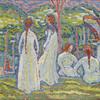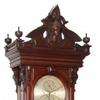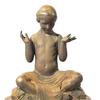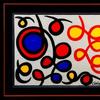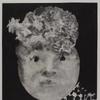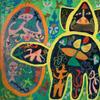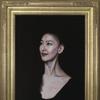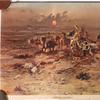Simeon Braguin - Chromatics
- PALM BEACH, Florida
- /
- April 23, 2021
Findlay Galleries is pleased to announce the opening of the exhibition, Chromatics, showcasing the colorful abstract works by an American visionary artist, Simeon Braguin. This exhibition will open on Monday, May 3, 2021, at Findlay Galleries, Palm Beach.
Braguin was born in Kharköv, Ukraine, on January 12, 1907. At the outset of the Russian Revolution and Civil War, the Braguin family fled to New York. He grew up playing the Violin and his first job was as an accompanist in local silent movie theaters. Braguin took art classes at Columbia University and the Art Students League with Boardman Robinson. His first exhibition was In 1931, at the Marie Harriman Gallery in Manhattan, followed closely by a second at the Daniel Gallery. He also quickly developed into an accomplished photographer during that period and gained more than a passing acquaintance with Alfred Stieglitz and Georgia O’Keeffe.
Braguin relied on work in the field of illustration for sustenance, and by 1932, he was a staff illustrator for Vogue, a position that brought him high visibility in the world of fashion. His illustrations appeared in many magazines, including Mademoiselle and the Saturday Evening Post. He also worked with leading fashion retailers, including Saks, Bergdorf Goodman, and Bonwit Teller. He quickly rose to become art director for Vogue, working closely with its leading photographers, Edward Steichen and Cecil Beaton.
On the outbreak of World War II, he left Vogue and took a daring step; Braguin became a spy. In addition to being multilingual (he spoke Ukrainian, French, Italian, and English), Braguin was a photographer – all the skills needed by the Office of Strategic Services. After completing ten daring missions, Braguin sensed he was tempting fate and happily accepted an offer to “retire” with honors.
Following the War, Braguin returned to Vogue in New York. During the 1950s, Braguin’s unique amalgam of art and design was passed along to a young disciple named Andy Warhol. Warhol had arrived in New York in 1949 and produced many assignments under Braguin’s commission and direction. It was natural that Warhol’s drawings from this period should reflect his strong attraction to Braguin’s light and playful style.
From the early 1980s onward, each of Braguin’s paintings is marked by carefully balanced geometric shapes. This exhibition of works explores Braguin’s refreshing use of color and composition. His comprehensive skill of flawlessly executing simplicity in design aligns with his ability to embed emotion into his color forms. The translucency of the color fields show that he worked and reworked these sections, layering one color atop another until he achieved the desired effect of establishing a careful harmony. He drew his inspirations from moments of adventure, peace, and freedom, all experiences from the Connecticut River near Essex Harbor.
Visit Findlay Galleries, Palm Beach, to view this Exhibition. To view the full catalogue or explore the virtual Exhibition, visit our website, www.findlaygalleries.com
Contact:
James MuldoonFindlay Galleries
5616552090
jamesmuldoon@findlayart.com
165 Worth Avenue
Palm Beach, Florida
palmbeach@findlayart.com
5616552090
http://www.findlaygalleries.com
About Findlay Galleries
Celebrating 150 years in business, Findlay Galleries is an iconic family art business founded in 1870. Specializing in Impressionism, European Modernism, l'Ecole de Rouen, L'Ecole de Paris, and 20th Century American Art, the gallery represents over 100 artists and artist estates. Named Wally Findlay Galleries since 1965, the business was acquired in 1998 by James R. Borynack. A longtime Findlay executive, Borynack was committed to the relentless pursuit of veritable European period works and contemporary artists. In 2016 Borynack also acquired the David Findlay Jr. Gallery and merged the two. Since then, the gallery has operated under its original name from 1870, Findlay Galleries, and has continued to offer a strong collection of both period works and contemporary art, both European and American.




